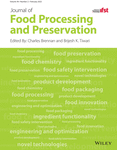Multi-Fabaceae flour for gluten-free pizza base: Rheology, processing, microstructural, and physico-sensory characteristics
Abstract
This study was focused on the formulation and processing of gluten-free variants of pizza base (PB) using the grains of the Fabaceae family. The Bengal gram, soya bean, black gram, and fenugreek seeds were milled to 200 µm size, and multi-Fabaceae gluten-free variant was prepared by blending these grains at 33:33:33:1 ratio. The rheologic characteristics of MFGF indicated that farinograph WAC, DDT, stability; amylograph viscosity values decreased compared with WF. The hardness and gumminess of the WF pizza dough were 17.43 and 5.85, respectively, and increased to 53.41 N and 44.70 kgf for MFGF. The weight (133.40–161.80 g) and breaking strength (37.43–83.41 N) of PB increased and the spread ratio (11.92–8.04) decreased in MFGFPB than WFPB. The use of CA improved the rheologic, textural, and physico-sensory properties of MFGFPB. The MFGFPB +CA had low in vitro starch digestibility (19.21) than WFPB (40.50). ELISA studies indicated that the gluten content of MFGFPB +CA was (15.77 ppm) within the permissible limit for GF products with a substantial increase in protein and dietary fiber.
Novelty impact statement
Celiac disease (CD) is one of the autoimmune genetic disorders triggered by the ingestion of gluten that affects mucosal damage of the small intestine. The only treatment for CD is lifelong strict adherence to a gluten-free (GF) diet. Recent studies revealed that the GF products available in the market are loaded with starch and sugars with poor nutrition and priced very high. While in CD, there is a requirement for high nutrition diet, due to poor digestion and absorption in the small intestine. Studies suggest to improve the nutritional quality and reduce the cost of GF products in the market and also to introduce a new range of commonly consumed foods as GF products without compromising the originality. The formulation and processing methodologies developed in this research is very helpful to address these issues and exploiting MFGFPB, as a carrier of functional ingredients with health benefit is having huge potential for industrial commercialization.
CONFLICT OF INTEREST
The authors declare that there is no conflict of interest with any person or organization.
Open Research
DATA AVAILABILITY STATEMENT
The data are available upon a reasonable request from the corresponding author.




